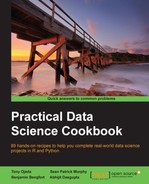Book Description
89 hands-on recipes to help you complete real-world data science projects in R and Python
In Detail
As increasing amounts of data is generated each year, the need to analyze and operationalize it is more important than ever. Companies that know what to do with their data will have a competitive advantage over companies that don't, and this will drive a higher demand for knowledgeable and competent data professionals.
Starting with the basics, this book will cover how to set up your numerical programming environment, introduce you to the data science pipeline (an iterative process by which data science projects are completed), and guide you through several data projects in a step-by-step format. By sequentially working through the steps in each chapter, you will quickly familiarize yourself with the process and learn how to apply it to a variety of situations with examples in the two most popular programming languages for data analysis—R and Python.
What You Will Learn
- Structure a data science project by using the data science pipeline
- Acquire and ingest data from files, data stores, and directly from the Web
- Clean, munge, and manipulate data into shape so that it is ready for analysis
- Draw insights from the data and conduct analyses that will deliver those insights
- Determine and apply the most appropriate model to your data
- Interpret the results of your analysis and modeling
- Communicate your results through a visualization, report, or application
Downloading the example code for this book. You can download the example code files for all Packt books you have purchased from your account at http://www.PacktPub.com. If you purchased this book elsewhere, you can visit http://www.PacktPub.com/support and register to have the files e-mailed directly to you.
Table of Contents
- Practical Data Science Cookbook
- Table of Contents
- Practical Data Science Cookbook
- Credits
- About the Authors
- About the Reviewers
- www.PacktPub.com
- Preface
- 1. Preparing Your Data Science Environment
- Introduction
- Understanding the data science pipeline
- Installing R on Windows, Mac OS X, and Linux
- Installing libraries in R and RStudio
- Installing Python on Linux and Mac OS X
- Installing Python on Windows
- Installing the Python data stack on Mac OS X and Linux
- Installing extra Python packages
- Installing and using virtualenv
- 2. Driving Visual Analysis with Automobile Data (R)
- 3. Simulating American Football Data (R)
- 4. Modeling Stock Market Data (R)
- 5. Visually Exploring Employment Data (R)
- Introduction
- Preparing for analysis
- Importing employment data into R
- Exploring the employment data
- Obtaining and merging additional data
- Adding geographical information
- Extracting state- and county-level wage and employment information
- Visualizing geographical distributions of pay
- Exploring where the jobs are, by industry
- Animating maps for a geospatial time series
- Benchmarking performance for some common tasks
- 6. Creating Application-oriented Analyses Using Tax Data (Python)
- 7. Driving Visual Analyses with Automobile Data (Python)
- 8. Working with Social Graphs (Python)
- 9. Recommending Movies at Scale (Python)
- Introduction
- Modeling preference expressions
- Understanding the data
- Ingesting the movie review data
- Finding the highest-scoring movies
- Improving the movie-rating system
- Measuring the distance between users in the preference space
- Computing the correlation between users
- Finding the best critic for a user
- Predicting movie ratings for users
- Collaboratively filtering item by item
- Building a nonnegative matrix factorization model
- Loading the entire dataset into the memory
- Dumping the SVD-based model to the disk
- Training the SVD-based model
- Testing the SVD-based model
- 10. Harvesting and Geolocating Twitter Data (Python)
- Introduction
- Creating a Twitter application
- Understanding the Twitter API v1.1
- Determining your Twitter followers and friends
- Pulling Twitter user profiles
- Making requests without running afoul of Twitter's rate limits
- Storing JSON data to the disk
- Setting up MongoDB for storing Twitter data
- Storing user profiles in MongoDB using PyMongo
- Exploring the geographic information available in profiles
- Plotting geospatial data in Python
- 11. Optimizing Numerical Code with NumPy and SciPy (Python)
- Introduction
- Understanding the optimization process
- Identifying common performance bottlenecks in code
- Reading through the code
- Profiling Python code with the Unix time function
- Profiling Python code using built-in Python functions
- Profiling Python code using IPython's %timeit function
- Profiling Python code using line_profiler
- Plucking the low-hanging (optimization) fruit
- Testing the performance benefits of NumPy
- Rewriting simple functions with NumPy
- Optimizing the innermost loop with NumPy
- Index
